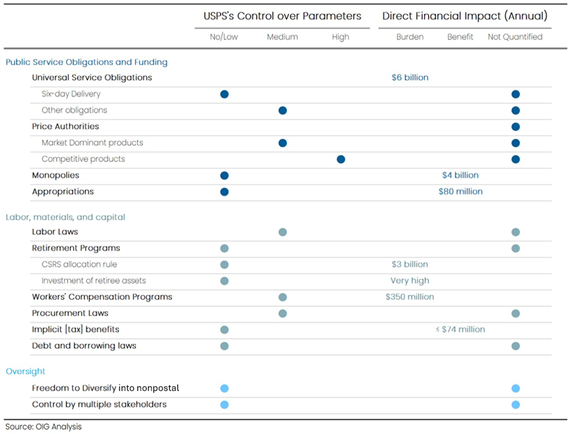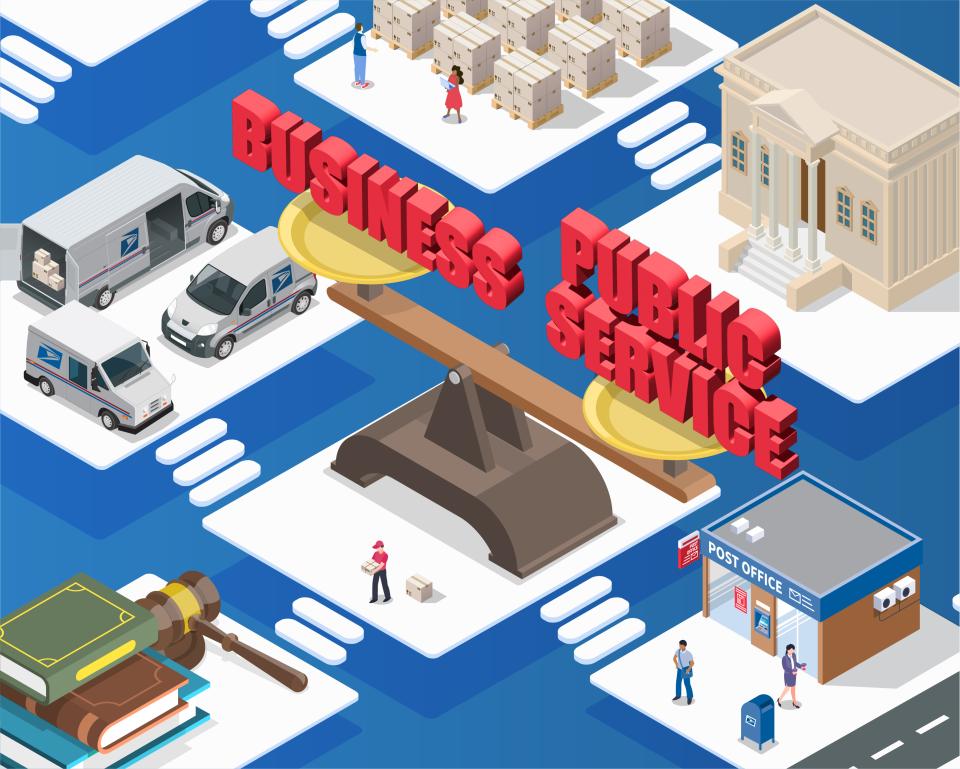Business or Public Service? Insights into the Unique Laws and Regulations Applying to the Postal Service
-
The Postal Service’s mission is to provide trusted and affordable universal service to the American public. While the agency operates with some of the flexibility of a private enterprise, it retains government ownership and civil service status for employees.
-
Unlike nearly every other federal agency, USPS is structured to be self-funded with the vast majority of its funding through revenue from postage. The agency is supported by the longstanding mailbox and mail delivery monopolies rather than from appropriations from Congress.
-
In recent decades, the steady decline in mail volume, substantial liabilities from health and retirement benefit programs, and growing competition in the package market have strained its financial sustainability.
-
In this paper, we highlight the unique legal framework in which USPS operates to show how it impacts decision-making, finances, and operations, and how it differs from the private sector and other government agencies.
The Postal Reorganization Act (PRA) of 1970 entrusted the Postal Service with a mission to provide trusted and affordable universal service to the American public. Congress established the U.S. Postal Service as an independent agency that receives the vast majority of its funding through revenue from postage. It is supported by the longstanding mailbox and mail delivery monopolies rather than from congressional appropriations. Over the last few decades, however, the steady decline of mail volume, the substantial liability of health and retirement benefit programs and, recently, an increasingly competitive package market have strained USPS’s financial sustainability.
In this white paper, the U.S. Postal Service Office of Inspector General (OIG) reviewed the laws applicable to the Postal Service, highlighting the differences with the private sector and other government agencies. We identified the laws and regulations that have had the most substantial impact on USPS’s business decision-making, finances and operations, and discussed their implications.
Level of Postal Service’s Control Over its Operations and Financial Impact

The Postal Service has relative freedom to structure its processing and delivery network to fulfill its public mission while balancing the obligation to be financially self-sufficient. It also maintains letter delivery and mailbox monopolies to help fund the infrastructure and other costs of providing the universal service, for example, to locations that may not otherwise be financially sustainable for a carrier to serve. However, according to the Postal Regulatory Commission, the net cost of the universal service has exceeded the value of the monopolies by $1.8 billion in FY 2022.
Despite recent reform, USPS also remains restricted to investing retirement assets in low-risk, low-interest federal securities, limiting the funding of retirement liabilities from returns earned through potentially more lucrative investments. The Postal Service’s unfunded retirement liability has increased by 85 percent since 2012, totaling $122 billion in FY 2023. In FY 2022, these underfunded liabilities would have resulted in an estimated surplus of $700 billion had the agency been allowed to invest in a more diversified portfolio of stocks and bonds over the prior 15 years.
To fund capital investments and operations, USPS pays a lower interest rate on borrowed funds than private sector companies do; however, the annual amount of borrowings is capped and the debt limit has not been adjusted to inflation or changed in over 30 years. Procurement laws and regulations are less restrictive than those applying to other federal agencies but may create disadvantages when compared to the relative agility of private sector competitors.
Additionally, as a government entity, the Postal Service is subject to oversight by multiple government entities, which helps ensure good and transparent governance principles, identify fraud, waste, and abuse, informing public discussion and debate, and influences strategic decision making. This oversight, as well as the restriction on the tenure of USPS’s governors, is distinct from private sector competitors.
Over the years, the inherent tension between public service obligations and financial sustainability has been intensified by increased operating costs, the substantial liability of health and retirement programs, and declining mail volumes and revenue. This tension raises questions over whether the “business like” model established by Congress in 1970 is optimally tailored to fulfill the Postal Service’s public service mission in the years to come.



